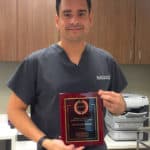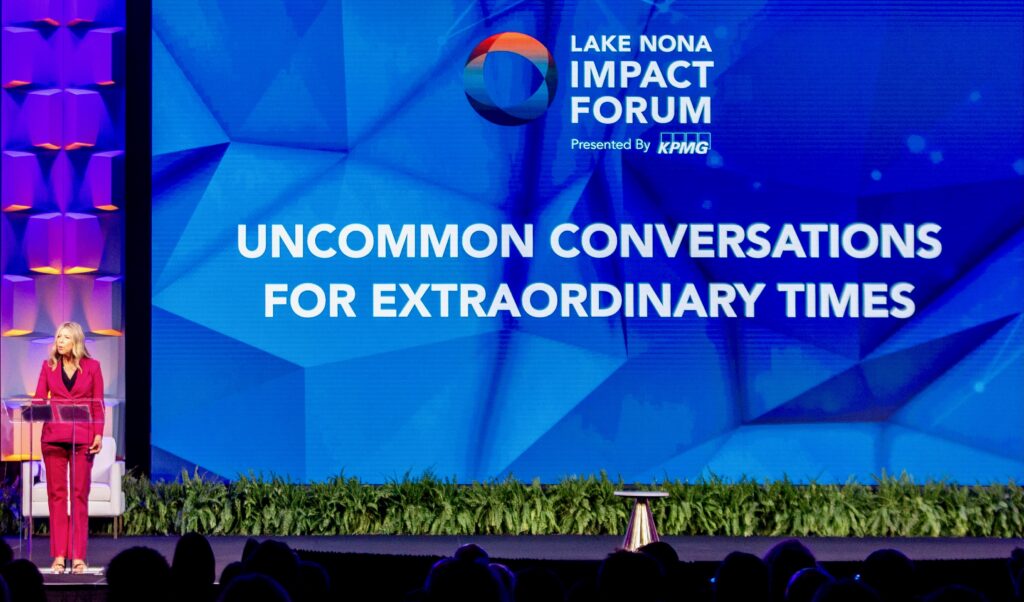
What is it about Lake Nona that draws presidents and big-name celebrities so dependably to our town? Here are some clues. For a start, we denizens of the Nonahood look upon our town as a hub for health, wellness and sports performance, now expanding to encompass art. Then, our community’s biggest annual event – at least measured by national importance, if not local participation – is the Lake Nona Impact Forum, the 13th iteration of which took place in our suddenly not-so-humble neighborhood on February 26-28.
As you went about your business that week, you likely had no idea that former president George W. Bush and basketball legend Magic Johnson had descended upon the KPMG Lakehouse to address health issues with the 750+ invited guests attending this year’s Forum. While Bush’s daughter Barbara, co-founder and chair of Global Health Corps, interviewed her relaxed father, who displayed unexpected wit, Magic Johnson wowed the crowd with an inspiring account of the challenges he has faced along his personal health journey.
Big names are not new to the Impact Forum. Speakers in recent years have included Bill Clinton (addressing the crowd the very day, three years ago, that Russia launched its attack on Ukraine), former UK Prime Minister David Cameron, philanthropist chef José Andrés, Jeff Bezos, Katie Couric, Chris Evert, Sanjay Gupta, John Grisham, Goldie Hawn, Martin Luther King III, Brooke Shields, Shaun White … the list goes on and on. A friend recently asked me, “How do they get all those big names together in one room anyhow?” A question, we are guessing, that Tavistock Vice President Gloria Caulfield, the mastermind behind the forum, might reveal to us someday.
In all honesty, little news had trickled out from the first twelve forum conclaves. It was as if the forum did not want to draw attention to itself, for reasons we can only speculate on. Was it because the forum is invitation-only, where just a few locals are admitted? Or was it for security reasons, given the elevated status of the speakers invited? Or some other consideration? We don’t know. But no worries, because we are happy that this “don’t tell” approach shifted over the past year as Tavistock created Facebook and LinkedIn accounts that provide timely updates about the forum that anyone can access and follow. (Just look for Lake Nona Impact Forum on either of those two apps.)
As at previous forums, the 50+ expert panels this year followed one another at a dizzying pace. Timings of the panels were strictly controlled, a remarkable achievement by the Tavistock team managing the event. The discussions showcased the unexcelled knowledge of an array of national leaders in health and wellness, who steadily stunned us with announcements of medical innovations of transcendental importance. You got the feeling you were hearing the news for the first time anywhere. Hollywood premieres of sorts, medical style.
Experts sharing the latest developments in medicine and wellness is, of course, the central focus of forum deliberations. But your reporter was moved most by the stories of average folks – patients, mostly – who brought to the stage an intimate, and profoundly personal, feel often missing from the more cerebral panel discussions. A doctor can sit before you to explain a pioneering operation, but the impact of the procedure really hits home when the patient herself appears on stage. These are special moments. Let’s explore three of these stories.
The Brain Implant, Blackfeet Nutrition and the Xenotransplant
Meet Nathan Copeland. In 2004, at age 18, a car accident left Nathan a C5 paraplegic, that is, paralyzed from the chest down. On stage, moderator Sanjay Gupta asked, “What were those first 10 years like?” The gentle, laconic Copeland responded, “Boring.” Then, in 2014, against the objections of his worried mother, Nathan agreed to have four minuscule electrode arrays, each supplied with 100 pin-shaped electrodes, inserted into his brain, the work of a company called Blackrock Neurotech. The implants, which to an observer resemble large buttons sprouting from Nathan’s scalp, would allow him to use a robotic arm to pick up small objects and gain sensation in his hands. Videos presented at the panel showed the effectiveness of the implants as Nathan cycled through his moves, toying with cubes, containers, and rocks of odd shapes and sizes. In one video, we watch President Obama perform a historic handshake, squeezing Nathan’s robotic fingers. Signals flowing back to Nathan’s brain make him feel, quite distinctly, Obama’s grasp. Mr. President, meet Mr. Cyborg.
For lunch that day, I ordered a cooked-to-order pasta dish from KPMG’s fine dining café. By chance, Nathan sat at a nearby table, his friendly gaze directed unmovingly at me. As I struggled with the slippery pasta, I felt caught in an awkward performance. Did my struggles remind Nathan of his own trials with his robotic arm? “You’re a brave man,” I sheepishly assured him as I strode back to the hall. The guy who proudly refers to himself as the world’s first cyborg is just that: a genuine hero. So what’s next for Blackrock Neurotech? According to CEO Marcus Gerhardt, that would be to make brain-computer interface (BCI) machines scalable and affordable, terms we heard often at this year’s forum.
Acclaimed National Geographic photographer David McLain then kicked off a deeply moving panel on health inequities. McLain, a native of Maine, has crisscrossed the country documenting cases of such injustice. His findings are troubling. Black women are much more likely to die in childbirth than white women; Hispanic women are inordinately susceptible to late-stage breast cancer; and African Americans die twice as often from diabetes than the general population. McLain raised the issue of amputations connected to diabetes, 85% of which, he says, are preventable. Blacks are three times as likely to suffer such amputations due to a dearth of awareness and compassion from the medical community. “We all deserve health equity,” stresses McLain, whose photographs and videos vividly document a health crisis we otherwise prefer to ignore.
Amid enthusiastic applause, Danielle Antelope-Gervais joined David McLain on stage. Danielle, the Executive Director of the non-profit Fast Blackfeet – the Food Access and Sustainability Team – switched to her native tongue to introduce herself. (A real treat. Seldom do we hear Native American speech live.) Danielle opened our eyes to the plight of her Montana community, which is now trying to reclaim a minimum of food security in the wake of government policies that swept away the tribe’s traditional source of food, the bison. By the late 1800s, nearly all the remaining bison in this country had been slaughtered (though some survived by crossing the border into Canada). In replacement, the U.S. government set up distribution facilities that supplied the Blackfeet with rations such as beef, cheese, flour and sugar – foods high in fat, sodium and sucrose. Over the ensuing decades, the Blackfeet developed staggering incidences of diabetes and other chronic diseases. Tribe members even forgot how to collect and cook their own traditional foods. But Danielle is changing that. A video produced by McLain shows Danielle in the fields of Montana gathering wild plants – the tribe’s ancestral food sources – and teaching her neighbors how to coax nutrition from them. And the bison, so central to Blackfoot culture, have returned, in part repopulated by the cohort that had escaped to Canada. That meat is now available year-round at Fast Blackfeet’s food pantry, where locals now also have access to cooking classes and recipe sharing. Relearning the food sources of their past now teaches the tribe how to safeguard food security for their future. An astounding development. “Come visit us in Montana!” a smiling Danielle hollered to the audience as she closed the panel.
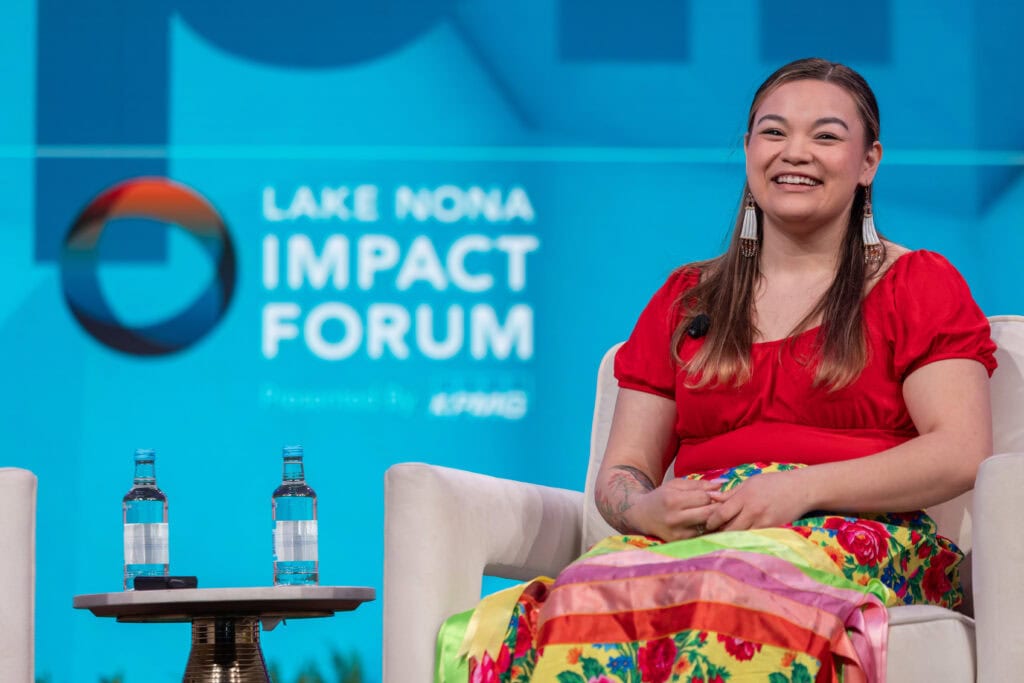
Our third unexpected hero is Towana Looney of Alabama, the world’s longest-living xenotransplant recipient. More about xenotransplants in a moment. First, let’s have a look at panelists Dr. Robert Montgomery of the NYU Langone Transplant Institute and his celebrated wife, mezzo-soprano superstar Denyce Graves. How did they meet? As Robert recounted, the pair, by chance sitting beside one another on a flight to Paris, talked non-stop to touchdown. Deplaning, they made a pact: He would agree to watch her perform an opera if she would observe one of his operations. The pact sealed their bond, and they married a few years later.
Robert, though, faced serious challenges resulting from his unlucky medical history, a condition known as familial dilated cardiomyopathy. At age 29, he was already outfitted with a defibrillator implant, and, as he aged, he regularly suffered cardiac arrests. One such attack dramatically interrupted a Broadway show in Manhattan. Two later events struck Robert on separate trips to Patagonia, the latter of which left him in a coma for a month. But his most frightening episode occurred in 2018 in a small town in southern Italy, when Robert’s heart stopped, and he was propelled unconscious to the floor of his hotel room. Local hospitals were ill-equipped to care for him. So, against medical advice, Robert booked an emergency flight home to New York City and checked himself into his own hospital, the Langone Transplant Institute, to seek a heart transplant. Later, halfway through that operation, the doctors assured Denyce that all was going well. By the way, they said, don’t worry, but Robert has no heart at the moment. “What!? He has no heart!?,” Denyce shrieked. Nonetheless, the Langone doctors successfully inserted a replacement heart into Robert’s chest thanks to a donor who had succumbed to Hepatitis C. Robert subsequently had to treat and cure himself of that ailment. “I’m hard to kill,” he quips.
Thunderous applause greeted Towana Looney as she strode on stage sporting a dark gray caftan. Her entrance electrified the audience. Standing before us was the one human being who has lived the longest – three months so far – following a xenotransplantation. You don’t know that word? Neither did I. The dictionary defines the term as “a tissue graft or organ transplant from a donor of a different species from the recipient.” In Towana’s case, the species was a pig, and the organ was a kidney, a gene-edited kidney.
Can you imagine the bravery of an otherwise ordinary woman who volunteers to undergo such an experimental operation so fraught with risk? But Towana had proven her medical courage earlier in life when she donated one of her kidneys to her mother. “The donor has to be of the family,” Towana was told at the time. Years passed, and Towana’s own remaining kidney began to fail. Anger welled up within her as she learned that her only recourse was dialysis.
Here, Dr. Montgomery interjected the unwelcome fact that the odds of securing a transplant are not good for dialysis patients. On average, for patients like Towana, an offer for a kidney transplant donation emerges once every 10 years. But the alternative – not obtaining a transplant – is dangerous as well: 50% of dialysis patients die within five years. After nearly a decade on dialysis, Towana was ready to try a new approach, a xenotransplantation, though her family members pleaded with her not to submit to that operation. Towana, however, was built of stronger stuff. “If I can do it, then anyone can do it!” she proudly announced, showing a measure of mettle many of us wish we, too, possessed. May the months and years stretch out ahead for Towana Looney.
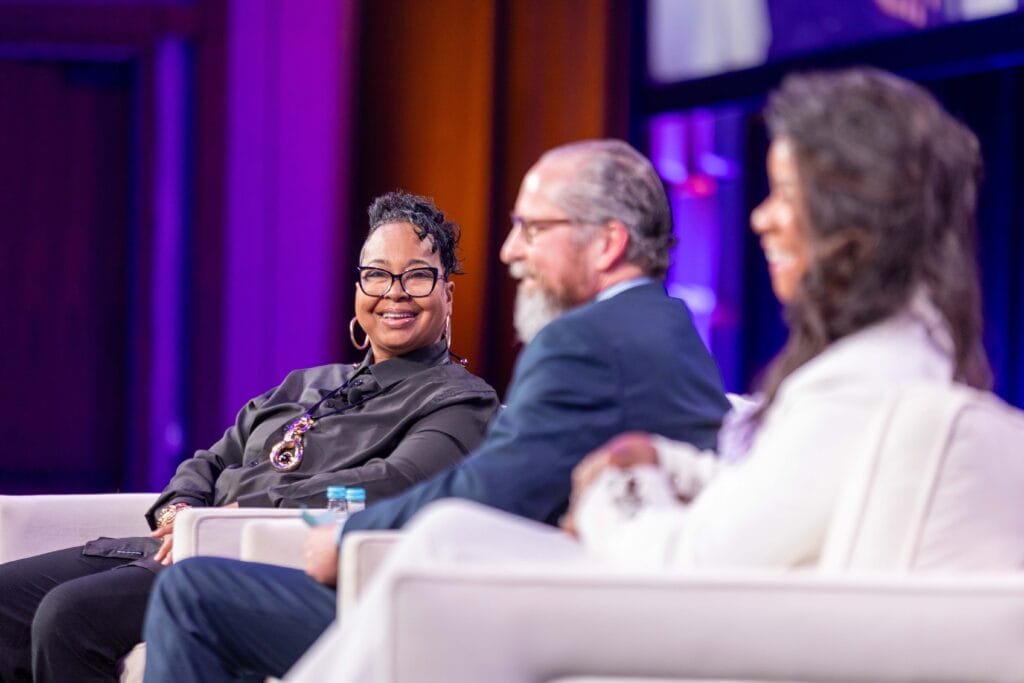
A Cerebral Drenching at the Impact Forum
Reporting with any sense of completeness on the torrent of news gushing forth at a Lake Nona Impact Forum is an exercise in futility. This article may be the closest to such an effort that you may find anywhere. A future article on these pages might offer a deeper look into some of the more startling innovations in health showcased at this year’s forum. For now, here’s some of the buzz we overheard over the three days.
A new star moderator at this year’s forum was science correspondent Matt Kaplan for The Economist. In a panel dubbed “I Told You So – The Suppression of Science,” Kaplan schooled us on Louis Pasteur’s theft of research conducted by a colleague, Henri Toussaint, for the development of an anthrax vaccine. Pasteur presented the research as his own. Who knew? We’ll probably still keep drinking pasteurized milk, though. … In the following panel, Kaplan addressed the ethical questions surrounding human longevity with Dr. Venki Ramakrishnan, the former president of the Royal Society and Nobel laureate in chemistry. Over the years, forum panelists have obsessed over this topic. The view often aired at the forum is that we should all seek out ways to live longer lives. Who could argue otherwise? Not so fast, says Ramakrishnan. As economics teaches us, what may be good for an individual is not necessarily good for a community, a nation or, for that matter, the world. Sure, dramatic advances in health, nutrition and economic well-being have lengthened our lives over the past century, and of course we welcome that development. But pursuing medical means specifically to prolong human life for its own sake seems to fall into a different category. Our current demographics warn us that there soon may not be enough young people to support our growing elderly population. In other words, even if we can prolong human life, should we? Perhaps a future Impact Forum will explore this issue in more detail. …
Women’s health gained a more prominent profile at this year’s panels, one of which was led by Carolee Lee of Women’s Health Access Matters (WHAM). The discussions on this subject took a tack rarely heard elsewhere, which is that men must be invited to engage in our national dialogue on women’s health. The subject must not remain the private preserve for women, in a sort of segregation of the sexes. Currently, women make 80% of health decisions and health purchases, but only 2% of health investments are devoted to women’s health. Plenty of work lies ahead in this realm. …
CNN’s Sanjay Gupta, in two separate panels, curiously stressed that thesefForums are “more important than ever.” Was he making an oblique reference to the current chaos in Washington, where funding cuts threaten needed medical research? … Later, in an exhaustive discourse, former Treasury Secretary and Harvard University President Larry Summers excoriated the current administration’s economic policies. “Tariffs,” he said, “are like radiation.” Both are good for certain uses, but lethal if applied indiscriminately. … The Bay State seemed to dominate proceedings on Day 2 of the forum. The morning’s two first panels featured former U.S. representative Patrick Kennedy and Charlie Baker, former governor of Massachusetts, both speaking on mental health. Baker, now president of the NCAA, is urging state governments to prohibit betting on college sports. The gambling addiction, he says, starts as a trickle, but eventually develops into a serious mental health issue … One forum panel, “Healthy Hustle,” served to showcase the career of Shark Tank celebrity and investment phenom Daymond John, founder of the FUBU clothing line (and a big fan of our favorite local sculptor Jëfrë). “I’m the only Black American on TV who did not come from politics or sports,” John announced.
In 2024, the Impact Forum inaugurated an “Adversity to Impact Award.” This year’s awardee was two-time cancer survivor and Harvard Business School grad Kathy Giusti, the founder of the Multiple Myeloma Research Foundation. Rarely would you meet a more inspirational individual than Kathy, who has devoted her inexhaustible energy to fighting the scourge of multiple myeloma. Thirty years back, she was diagnosed with that disease and told she had three years to live. At the forum, we were awed to view video testimonials by several stars – David Letterman, Cindy Crawford, Matt Damon – extolling Kathy’s superhuman achievements, plus photos of Kathy with the three U.S. presidents she has worked with. In the 1990s, no drugs existed for multiple myeloma; now there are 15. That same decade, no research focused on the disease; now the Multiple Myeloma Research Foundation supports 20 research labs. All this thanks to work guided by one supremely dedicated individual. The Adversity to Impact Award presentation offered a touching scene when, to Kathy’s utter surprise, her twin sister Karen, who decades earlier had donated life-saving bone marrow to Kathy to fight the myeloma, stepped on stage to hand her the prize.
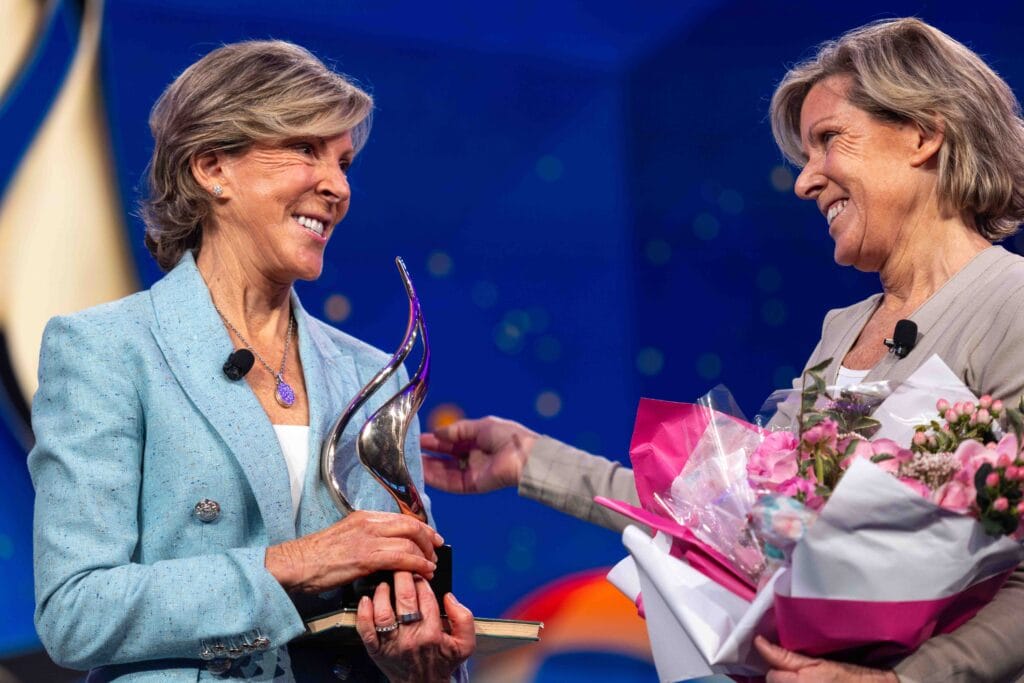
So that’s our abbreviated report on this year’s Impact Forum. Much more could be added to this account, but we’ve regrettably run out of space. Let’s just end by recalling that line from Sanjay Gupta. Yes, the Lake Nona Impact Forum really is more important than ever.
